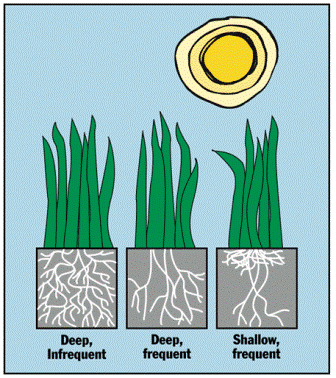How to Water Your Lawn in Hot Weather
Your grass needs water to grow and stay healthy, but both over-watering and under-watering can harm your grass. HOW you water 
(Watering) Mistakes Were Made
The most common mistake homeowners make when watering the grass is that they water often, but not very deeply. This results in roots that stay near the surface where the water is, instead of growing down deep into the soil. The grass then becomes dependent on frequent watering, and if you don’t keep up with it, the roots dry out very quickly in the summer heat and drought, creating perfect conditions for thatch and disease.
The next most common mistake is watering the lawn deeply, but too often. When the ground is constantly saturated, the waterlogged conditions will cause the roots to be thin and stunted or even rot, in the worst cases. The grass becomes weak and off-color, and prone to disease.
What time of day is best?
In the summer, the sun’s heat evaporates water from your lawn more quickly. The best time to water is first thing in the morning when it’s cool and there is little wind, between 6 – 8:00am. If that’s not possible, try for 4 pm – 6 pm, or use a timed sprinkler. You want to give the water a chance to seep in before nightfall or it’ll be soggy.
How Deep?
Lawns need about 1 – 1 ½ inches of water each week in the summer, from rain or irrigation. To achieve this, you’ll want to water each section of the lawn for about an hour each time. This way the water gets down to the root zone and deep into the soil to encourage the grass to shoot roots down, where they can thrive off untapped nutrients and be protected from insects, disease, and drought.
How Often?
Instead of watering daily, spread out your schedule. In heavier clay soils, you’ll need to water once a week in the summer. Sandy soils may need watering up to twice a week. You can use a rain guage (or even an empty tuna can) to measure the amount of water each week. Your summer watering schedule will vary depending on the rain and temperatures in your area.
How to Tell if Your Grass is Getting Enough Water
Properly watered lawns will be green and dense. Here are a few signs your lawn needs more water:
- The ground feels dry and excessively hard
- The lawn develops faded yellow or brown spots
- When you walk across your lawn, your footprints don’t disappear completely
- For non-bluegrass varieties, if your lawn begins to develop a gray or bluish hue, this means it’s lacking essential moisture in the blades
Excess water can cause trouble as well though, so don’t go overboard (no pun intended). Too much moisture can cause weeds and fungi to spread, rotted roots, and soil compaction. If you see puddles or runoff, you’re watering too much!
Maximize Your Watering Efforts
Improving the health of your soil allows water to be absorbed and used effectively. To promote drainage & fight standing water, check out our liquid lawn aerator, Aerify PLUS and our liquid soil activator, Nature’s Magic.
Nature’s Lawn & Garden Inc. has been serving customers in person and online for over 40+ years. We provide professional advice as well as high quality, easy to use, DIY products for natural lawn and garden care, for customers all over North America.


